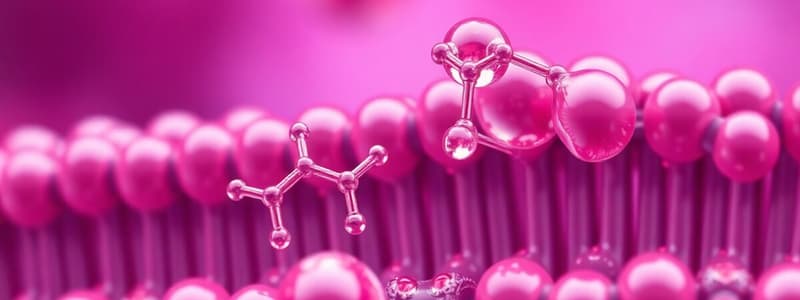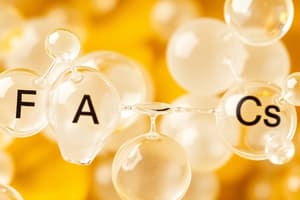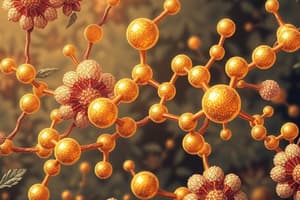Podcast
Questions and Answers
What property do fatty acids possess due to their structure?
What property do fatty acids possess due to their structure?
- Hydrophobic only
- Hydrophilic only
- Amphipathic (correct)
- None of the above
Which of the following fatty acids is classified as a saturated fatty acid?
Which of the following fatty acids is classified as a saturated fatty acid?
- Stearic acid (correct)
- Linoleic acid
- Arachidonic acid
- Oleic acid
What are polyunsaturated fatty acids (PUFAs) characterized by?
What are polyunsaturated fatty acids (PUFAs) characterized by?
- Having one double bond
- Being derived from saturated fats
- Having no double bonds
- Containing two or more double bonds (correct)
Which function is NOT served by lipids in the human body?
Which function is NOT served by lipids in the human body?
What is true about essential fatty acids?
What is true about essential fatty acids?
Which of the following statements about eicosanoids is correct?
Which of the following statements about eicosanoids is correct?
What is the general formula for fatty acids?
What is the general formula for fatty acids?
Which of the following fatty acids contains the longest carbon chain?
Which of the following fatty acids contains the longest carbon chain?
Flashcards
Lipid solubility
Lipid solubility
Lipids are insoluble in water but soluble in non-polar solvents like benzene, chloroform, acetone, and ether.
Lipid function 1
Lipid function 1
Lipids are structural components of biological membranes.
Lipid function 2
Lipid function 2
Lipids provide energy storage, mainly as triacylglycerols.
Lipid function 3
Lipid function 3
Signup and view all the flashcards
Fatty Acid Structure
Fatty Acid Structure
Signup and view all the flashcards
Saturated Fatty Acid
Saturated Fatty Acid
Signup and view all the flashcards
Essential Fatty Acids
Essential Fatty Acids
Signup and view all the flashcards
Eicosanoids
Eicosanoids
Signup and view all the flashcards
Study Notes
Lipids
- Lipids are insoluble in water but soluble in fat solvents (e.g., benzene, chloroform, acetone, ether).
- Lipids are physiologically important for humans and have four major functions.
- They are structural components of biological membranes.
- They store energy reserves mainly as triacylglycerols.
- Lipids and lipid derivatives act as vitamins and hormones.
- Bile acids and bile salts emulsify fats.
Lipid Classification
- Lipids are classified into simple lipids (fatty acid + glycerol), compound lipids (fatty acid + alcohol + other group), and derived lipids (products of simple or compound lipid hydrolysis).
- Simple lipids include neutral fats (TAGs) and waxes.
- Compound lipids include phospholipids and glycolipids.
- Derived lipids include steroids, carotenoids, and fat-soluble vitamins.
Fatty Acids
- Fatty acids are long-chain hydrocarbon molecules with a carboxylic acid group at one end.
- The general formula is R-COOH.
- -R (hydrocarbon chain) makes fatty acids hydrophobic.
- -COOH (carboxylic acid group) makes fatty acids hydrophilic.
- Fatty acids have an amphipathic nature (both hydrophobic and hydrophilic regions).
Fatty Acid Classification
- Fatty acids are classified as saturated or unsaturated, based on the presence or absence of double bonds.
- Saturated fatty acids lack double bonds.
- Unsaturated fatty acids contain one or more double bonds.
Saturated Fatty Acids
- Saturated fatty acids are further categorized by chain length (short-chain – C2 to C10, long-chain – > C10).
- Examples of saturated fatty acids include butyric acid (C4), palmitic acid (C16), and stearic acid (C18).
- Saturated fatty acids with fewer than eight carbon atoms are liquid at body temperature, while those with more than ten are solid.
Unsaturated Fatty Acids
- Unsaturated fatty acids have one or more double bonds.
- Examples: oleic acid (C18:1), linoleic acid (C18:2), linolenic acid (C18:3), and arachidonic acid (C20:4).
- Polyunsaturated fatty acids (PUFAs): contain more than one double bond.
- Essential Fatty Acids (EFAs): linoleic and linolenic acids; the human body cannot produce them and must obtain them from the diet.
Eicosanoids
- Eicosanoids are hormone-like molecules derived from polyunsaturated fatty acids (PUFAs) with 20 carbon atoms (eicosanoids).
- Eicosanoids act locally within cells or on adjacent cells.
- They are produced by most mammalian tissues.
Eicosanoid Classification
- Eicosanoids are classified into cyclic (prostaglandins, prostacyclins, thromboxanes) and acyclic (leukotrienes, lipoxins) compounds.
Prostaglandins
- Synthesized by most tissues.
- Functions: inflammation, uterine contractions, inhibition of gastric secretion (some cause vasodilation, others vasoconstriction).
Prostacyclins
- Produced by the endothelium of blood vessels.
- Functions: vasodilation, inhibit platelet aggregation.
Thromboxanes
- Produced by platelets.
- Functions: vasoconstriction, platelet aggregation
Leukotrienes
- Produced by leukocytes, platelets, and mast cells.
- Released during severe allergic reactions.
- Functions: increase vascular permeability, bronchospasm.
Studying That Suits You
Use AI to generate personalized quizzes and flashcards to suit your learning preferences.




